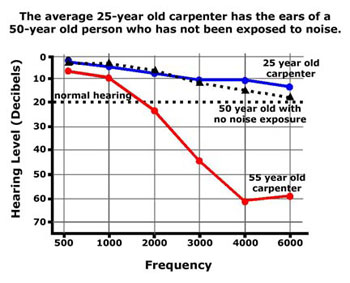Explainer: When loud becomes dangerous
Loud noise can put more than your hearing at risk

Headphones allow people to hear music clearly, but sometimes there's a temptation to crank up the volume to unhealthy levels. And more than your ears may suffer.
jean-marie guyon/ iStockphoto
By Janet Raloff
Please see an updated explainer on noise-level risks; it offers more focused recommendations on decibel limits for children and teens.
It’s not unusual for people to leave a rock concert with an incessant buzz or ringing in their ears. That’s one sign that the music was too loud. But power tools, especially lawn mowers and wood chippers, can be equally loud. Even heavy traffic can create a din that may pose a risk to hearing.
And sounds do not even have to be deafeningly intense to prove harmful.
Scientists measure sound, at its source, in units known as decibels (DESS-ih-buls). The decibel scale is not linear. Instead, each 1-decibel rise equals a 10-fold increase in sound intensity. Zero decibels is the quietest level that a young person with normal hearing can detect. Our ears are tremendously sensitive. They can hear throughout a range exceeding 140 decibels. Yet anything above 85 decibels puts the ears at risk, according to the U.S. Environmental Protection Agency.

The human ear evolved to detect 10 decibel whispers and rustles in a quiet woodland — something that might warn of dangers. Yet today, few people live in such quiet surroundings. With people whispering or shuffling through pages of a book, even a library may run 35 decibels. Outdoor traffic and bird calls can sometimes raise the sound level in bedrooms to 40 decibels. Compare those to kitchens. When garbage disposals, mixers, blenders or dishwashers get going, noise levels can reach 80 or 90 decibels. A vacuum cleaner may let out an 80-decibel roar. And televisions, stereo equipment and headsets may expose a teen’s ears to sounds exceeding 100 decibels. That is 10 billion times as intense (as measured in acoustic energy carried by sound waves) as just 1 decibel.
Outdoors, noises tend to be even louder. Moderate urban traffic can run 70 decibels. Passing trains and thunder may register 100 decibels. A music club or jet takeoff from a distance of 610 meters (2,000 feet) can bombard the ears at 120 decibels. The deck of a Navy carrier can hit 140 decibels as a jet takes off.
How the ear responds
Sound travels through the air in waves that compress, stretch and then repeat. The compression exerts a push on things, such as ear tissue. The stretching back out of the wave pulls on the tissue. These aspects of the wave cause whatever a sound hits to vibrate.

Two major features distinguish sound. The first is its pitch, or frequency. This tends to be high, like a bird’s tweet, low like a tuba or somewhere in between. But in terms of health, the more important feature is its energy. That’s the decibel levels, or what we think of as how loud sounds are.
The outer ear is shaped a bit like a horn. It collects sound and funnels it through a series of structures to the inner ear. Ossicles — the three tiniest bones in the body — transmit sounds to a fluid-filled snail-shaped structure. It’s called the cochlea (KOAK-lee-ah). Inside are microscopic “hair” cells. They contain bundles of tiny hair-like strands that wave back and forth in response to sounds. Their movements send messages to the brain that will register the sound of various pitches.
These hair cells are very fragile. Loud sounds can damage them — or kill them altogether. And they never grow back. So, as hair cells die off, people lose their ability to detect sounds. Hair cells that respond to high-pitched sounds tend to die off first. So an early sign of noise-induced hearing loss can be an inability to hear high-pitched sounds.
Just as the eyelid tends to close in bright light, to shield the eye, muscles in the ear can try to shut off the entryway to shield inner tissues from overly loud sounds. This action is known as the acoustic reflex. The problem is, it can’t prevent all sound from entering. So very loud sounds will overwhelm it. Moreover, it takes a few hundredths of a second for the brain to realize this reflex is needed before it goes into effect. For very short percussive sounds — thunder, a gunshot or a firecracker — the sound may enter and do its damage before the ear has had time to turn on this semi-protective reflex.
The damage noise can cause
As hair cells in the tiny cochlea become bombarded by loud sounds, they can become damaged and fail to work. This can cause a temporary deafness, or perhaps only an inability to hear high-pitched sounds. Most times, those cells will recover. But if the sounds are loud enough — and especially if they come without warning — they might do real damage. A single gunshot near unprotected ears can cause permanent damage.

As hair cells that are sensitive to high-pitch die off, people may have a hard time understanding their environment. Music may sound different. Some words or high-pitched speakers may be hard to interpret. And no hearing aid will help.
Sometimes, before that selective hearing loss starts to occur, people will develop ghost sounds. Called tinnitus (TIN-ih-tus), these are ringing, buzzing, clicking, hissing or roaring sounds. Tinnitus can occur continuously or just now and again. It can appear to come from one ear or both.
The sounds appear real. In fact, bent or broken hair cells will be leaking an electrical signal that the brain will misread as sound. These ghost sounds can be distracting and annoying. And in some people, they may last for years, even decades.
William Shatner, best known for playing Captain James T. Kirk on Star Trek, the 1960s television show, developed tinnitus during the filming of the “Arena” TV episode. “I was standing too close to a special effects explosion and it resulted in tinnitus,” he told the American Tinnitus Association. “There were days when I didn’t know how I would survive the agony. I was so tormented by the screeching in my head,” he says.
But hearing damage isn’t the only risk that loud noises pose. They can distract children trying to work or listen. This can hurt how well they learn or perform. Noises can keep people from sleeping well. Loud noises can even stress the body, triggering a rise in blood pressure and certain fight-or-flight hormones, while blood levels of cholesterol can climb. Some studies have even attributed noise (such as living near airports) to aggravating mental illness.
If such health effects “seem scary, they should,” an EPA report says. Keep in mind, it says, “noise is a danger.” That’s why doctors and public health officials ask everyone to protect their ears.
According to the American Speech-Language-Hearing Association, you know it’s too loud if you must raise your voice for others to hear you, if you can’t understand someone speaking from a meter (about 3 feet) away, if normal speech sounds dull or muffled after leaving a noisy area, or if your ears hurt or produce those ghost sounds.
Power Words
(for more about Power Words, click here)
acoustic Having to do with sound or hearing.
acoustic reflex A natural and involuntary muscle contraction that occurs in healthy people when they encounter loud sounds, especially those above 85 decibels. It’s one way the body attempts to shield the delicate inner ear from exposure to potentially damaging levels of sound.
cholesterol A fatty material in animals that forms a part of cell walls. In vertebrate animals, it travels through the blood in little vessels known as lipoproteins. Excessive levels in the blood can signal risks to the blood vessels and heart.
cochlea A spiral-shaped structure in the inner ear of humans and other mammals. The natural battery in the mammalian inner ear provides power to drive signals from the ear to the brain. Those signals travel along the auditory nerve.
decibel A measurement scale used for the intensity of sounds that can be picked up by the human ear. It starts at zero decibels (dB), a sound hardly audible to people with good hearing. A sound 10 times louder would be 10 dB. Because the scale is logarithmic, a sound 100 times louder than 0 dB would be 20 dB; one that’s 1,000 times louder than 0 dB would be described as 30 dB.
frequency The number of times a specified periodic phenomenon occurs within a specified time interval. (In physics) The number of wavelengths that occurs over a particular interval of time. (in music) The pitch of a sound. Higher wavelengths are higher pitched than lower wavelengths.
hair cells The sensory receptors inside the ears of vertebrates that allow them to hear. These actually resemble stubby hairs.
hormone (in zoology and medicine) A chemical produced in a gland and then carried in the bloodstream to another part of the body. Hormones control many important body activities, such as growth. Hormones act by triggering or regulating chemical reactions in the body
ossicles The body’s three tiniest bones — the malleus, incus and stapes. Their job is to amplify sounds approaching the inner ear so that the brain will eventually be able to interpret them. Found in the middle ear, these bones are the only ones that do not grow bigger after birth.
pitch (in acoustics) The word musicians use for sound frequency. It describes how high or low a sound is, which will be determined by the vibrations that created that sound.
stress (in biology) A factor, such as unusual temperatures, moisture or pollution, that affects the health of a species or ecosystem. (in psychology) A mental, physical, emotional, or behavioral reaction to an event or circumstance, or stressor, that disturbs a person or animal’s usual state of being or places increased demands on a person or animal; psychological stress can be either positive or negative.
tinnitus An uncontrolled and non-stop ringing or buzzing in the ears, usually triggered by tissue damage from exposure to loud noise. It can be short-lived, lasting hours or a day. In some instances, however, people may experience it for years or decades.







